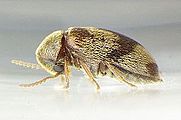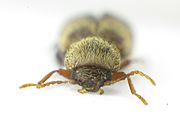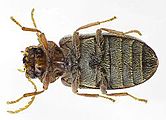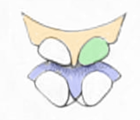Ochina ptinoides
| Ochina ptinoides | ||||||||||||
|---|---|---|---|---|---|---|---|---|---|---|---|---|

Ochina ptinoides on ivy |
||||||||||||
| Systematics | ||||||||||||
|
||||||||||||
| Scientific name | ||||||||||||
| Ochina ptinoides | ||||||||||||
| ( Marsham , 1802) |
Ochina ptinoides is a beetle ofthe rodent beetle family . The genus Ochina is represented in Europe with two subgenera and five species . In Central Europe, in addition to the species Ochina ptinoides , whichbelongsto the subgenus Citobium , the species Ochina latreillii can also be found.
In the Red List of Endangered Animals, Plants and Mushrooms in Germany and the corresponding Red Lists of Bavaria and Schleswig-Holstein , the species is listed under Category 3 (endangered). In Schleswig-Holstein's Red List of Beetles, an increase in the population of the species is noted.
Notes on the name
It was first described in 1802 by the Englishman Marsham under the name Crioceris ptinoides . The description is mainly limited to the color characteristics of the beetle, but the specific epithet ptinoīdes (derived from the generic name Ptīnus and ancient Greek ειδής, eidēs, similarly) expresses that the beetle is similar in shape to a pound beetle .
The generic name Ochina appears for the first time in 1821 in the catalog for the beetle collection of the French nobleman Dejean . Dejean takes on the name of Ziegler , the curator at the Zoological Cabinet in Vienna. In the preface to the catalog, Dejean mentions that, among other things, he visited Ziegler's collection in Vienna and adopted generic names from him. The explanation of the name Ochīna from ancient Gr. όχος óchos, charioteer, gives Schenkling a question mark. The subgenus Cittobium was separated from the genus Ochina in 1864 by Mulsant and Rey . The name Cittóbium is used by the two authors by Altgr. κιττός kittós, ivy, and βιόω bióo, I live, explain and refer to the beetle's host plant.
Two synonyms are mentioned in the Fauna Europaea . Ph.WJMüller described the species in 1821 under the name Ptilinus hederae (Ptilinus of the ivy) in an article entitled New Insects . The specific epithet hederae was used for the species for a long time. The second synonym goes back to an old description by the French Geoffroy , in which the binomial nomenclature is not yet used. Geoffroy describes in 1762 among the beetles that occur in the Paris area as the fifth species of the seventh genus Byrrhus a beetle, which he calls in French La vrilette brune à bandes grises (the brown rap beetle with gray bands). It is Byrrhus of give a wiki. βούρρος bōūrrhos, derived from shaggy dress, and Geoffroy also mentions in his description that the bands are caused by the gray hair. In 1785, Fourcroy , in collaboration with Geoffroy, also published a work on insects in the Paris area, in which the binomial nomenclature was used. Fourcroy expressly notes in the foreword that this is a continuation of Geoffroy's work by adding more insect species. Under the same French name La vrilette brune à bandes grises and with the same short Latin characterization as Geoffroy, Birrhus fasciatus is also listed as the fifth species of the 7th genus . The change from Byrrhus to Birrhus is probably not a typographical error, but is due to the fact that the generic name Byrrhus had meanwhile been determined by Linnaeus (1767) for a different genus of beetles. The specific epithet fasciatus means banded. This explains the synonym " Birrhus fasciatus Geoffroy in Fourcroy 1785".
Description of the beetle
The beetle is 2.5 to just under four millimeters long. The length and width of the arched body is elongated oval in plan view (Fig. 5), the wing covers are slightly depressed in the middle in the front third. The upper side is reddish brown, the lower side darker, the legs, feelers and buttons and the end of the wing covers lighter. The beetle is largely covered with lying, gray, short and somewhat shaggy hairs. On the one hand, this extends to the underside, as well as the head, jaw, antennas, legs and buttons; on the other hand, it is partially dense, elsewhere it is sparse or absent. In particular, this causes the wing covers to have two gray cross bars.
The head is tilted down and bent back over 90 degrees if the beetle is disturbed (Fig. 3). However, the head is only slightly drawn into the breast shield and there are no cavities on the underside of the breast section to accommodate head sections. Even when the beetle is stretching, only the large, rounded, and strongly arched dark eyes are visible from above from the head . The head of the female is slightly wider than that of the male. The forehead is large and only slightly arched. The head is fine, dense and slightly wrinkled and granulated with flat umbilical points (Fig. 4). The raised and edged head shield is separated from the forehead by a clearly deepened, slightly curved groove. The upper lip is short and wide, its front edge is slightly outlined and covered with hairs. The short, wrinkled and hairy upper jaws end in a smooth, lightened, two-tooth point. The jaw probes are four-part, the lip probes are three-part. Both end with an egg-shaped end link (Fig. 1).
The eleven-part antennae reach about half the body length. The thick and long base link is slightly curved. The following limb is small and rounded to ovoid. The third is slender and slightly expanded inwardly before its end. The following seven links are a little longer than they are wide and are slightly serrated inward. The end links are not wider than the preceding ones. The end link is elongated and ends slightly pointed. In the female, the antennae are somewhat weaker and more bluntly sawed than in the male.
The pronotum is mostly hairy, only in the middle it often shows a bald and therefore brown area of different sizes. The pronotum is wider than it is long, wider than the head and slightly narrower than the elytra . The sides of the pronotum are pulled down, the side edges sloping forward. The side edges form a right angle with the front edge, the transition to the rear edge takes place in a wide arc. The front edge is hooded over the inclined head, but does not lie on it. It is cut off fairly straight, only showing a slight indentation behind the eyes (Fig. 2). In contrast to Ochina latreillii, the lateral margins are almost straight and only slightly margined. A border is indicated in the middle of the pronotum base. The puncture of the pronotum is fine and dense, in front it is somewhat coarser.
The label is rounded, triangular and almost bare.
The elytra are elongated oval and three times as long as the breast shield. Over the first two thirds they widen almost in a straight line and only slightly, at the end they are rounded off together. The shoulders are rounded and protruding. In the vicinity of the label, they are slightly raised like bumps. Each wing cover is sparsely hairy to bald at the base in a large patch between the shoulder and shield, at the end of the wing cover and in a horizontal stripe behind the middle, so that the thick hair between them forms two wide, partially jagged cross bars of variable shape. The elytra are dense, fine and irregularly dotted. The puncture is weakly wrinkled further in front, it becomes weaker towards the rear. It does not form any point stripes. Slightly raised longitudinal lines are indicated.
The dark brown, shiny underside (Fig. 6) is slightly arched and quite densely hairy. There are no recesses for inserting the legs. Chest and abdomen are dense and rough punctured on the underside, only the rear chest is somewhat smoother. The fore-chest (Fig. 8 brown-yellow) does not continue horizontally between the front hips, as in Ochina latreillii, beyond the rear edge of the fore-hip cavities (Fig. 8 green), but slopes downwards at the level of the rear edge.
The legs are moderately robust. The elongated tarsi are all five-limbed, the first limb is as long as the three following combined. The rear hip (Fig. 7 red) is not curved uniformly on the inside as in Ochina latreillii , but drawn out to an obtuse angle in the outer third.
biology
The species overwinters as a larva in dead branches of ivy , where it eats its way forward in the pulp. It pupates in late April or early May just under the bark. The doll chamber consists of an elongated, round cavity. The beetles appear in June. When it gets dark you can find clusters of beetles on dead branches.
distribution
The range of the species is not contiguous. On the one hand, the beetle occurs in western Europe from Denmark , through Germany , the Czech Republic , Austria to Italy and Sicily as well as all countries west of it. To the east, it is found in Greece , Turkey , the Middle East , parts of North Africa, and many areas of Russia . But it is missing in between in a wide strip from Poland to the Adriatic Sea . In Central Europe the beetle is absent in the alpine altitude range .
literature
- Heinz joy , Karl Wilhelm Harde , Gustav Adolf Lohse (ed.): The beetles of Central Europe . tape 8 . Teredilia Heteromera Lamellicornia . Elsevier, Spektrum, Akademischer Verlag, Munich 1969, ISBN 3-8274-0682-X . P. 34
- Klaus Koch : The Beetles of Central Europe Ecology . 1st edition. tape 2 . Goecke & Evers, Krefeld 1989, ISBN 3-87263-040-7 . P. 268
- Gustav Jäger (Ed.): CG Calwer’s Käferbuch . K. Thienemanns, Stuttgart 1876, 3rd edition p. 396
Web links
Individual evidence
- ↑ a b c d Ochina ptinoides in Fauna Europaea. Retrieved November 29, 2014
- ↑ a b Ochina at Fauna Europaea. Retrieved November 29, 2014
- ↑ a b Cittobium (subgenus) in Fauna Europaea. Retrieved November 29, 2014
- ↑ Spelling after first description: Franco Andrea Bonelli: Specimen Faunae Subalpinae Fasciculus 1 as the 12th species in Memorie della reale Societa agraria di Torino Tomos IX, Torino 1812 p. 167 Preview in the Google book search traditionally latreillei , often latrellii
- ↑ Red List of Endangered Animals in Germany ( Memento of the original from March 1, 2016 in the Internet Archive ) Info: The archive link was inserted automatically and has not yet been checked. Please check the original and archive link according to the instructions and then remove this notice.
- ↑ Red List of Endangered Heteromera in Bavaria
- ↑ Die Käfer Schleswig-Holstein, Rote Liste p. 26 ( page no longer available , search in web archives ) Info: The link was automatically marked as defective. Please check the link according to the instructions and then remove this notice.
- ↑ a b Thomas Marsham Entomologia Britannica Tomus I Coleoptera London 1802 p. 228
- ↑ Sigmund Schenkling: Explanation of the scientific beetle names (species)
- ↑ Catalog de la Collection de Coléoptères de M. le Baron Dejean Paris 1821 p. 40
- ↑ Court and State Schematism of the Austrian Empire Vienna 1807, mention of the Ziegler's preview function in the Google book search
- ↑ a b c Sigmund Schenkling: Explanation of the scientific beetle names (genus) in detail in the 2nd edition 1922 .
- ↑ a b c d E. Mulsant, Cl. Rey: Coléoptères der France, Térédiles Paris 1864 p. 237 Explanation and definition Cittobium , p. 240ff Species description as Ochina hederae , Plate VII Differences between Ochina ptinoides and Ochina latreillii , here as Ochina latreillei
- ↑ a b Ph. WJ Müller New insects in eds .: Germar, and Zinken, called summer: Magazine of insects, 4th volume, Halle 1821, p. 193 Preview in Google book search
- ↑ a b E. L. Geoffroy: Histoire abregée des insectes, qui se trouvent aux environs de Paris Paris 1762 p. 112
- ^ AF De Fourcroy (ed.): Entomologia Parisiensis Pars prima Paris 1785 p. 26
- ↑ Byrrhus (subgenus) in Fauna Europaea. Retrieved December 1, 2014
- ^ A b W. F. Erichson (et al.): Natural history of the insects of Germany, 1st division, Volume V, 1st half of Berlin 1898, p. 140 as Ochina hederae
- ^ Canon Fowler: The Coleoptera of the British Islands Vol. IV London 1849 ff. P. 194 as Ochina hederae
- ↑ Coleo-net, table for Anobiidae (Ptilidae)
- ↑ F. Español: Sobre algunas Anobiidae (Col.) de Turquia recojidos por el Dr. W. Wittmer p.6
- ↑ Map of Fauna Europaea ( Memento of the original from December 13, 2014 in the Internet Archive ) Info: The archive link was automatically inserted and not yet checked. Please check the original and archive link according to the instructions and then remove this notice.







